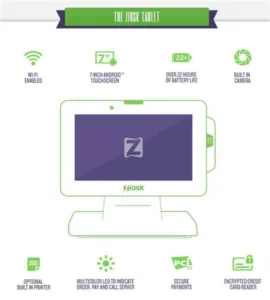Olive Garden, the Darden Restaurants Italian cuisine chain in the US, has announced that it will be using tablets in all of its restaurants this year. After a successful trial run in 2014, Olive Garden decided to make the tablets a permanent part of its restaurants.
The tablet that will be used is the Ziosk, a 7″ Android based tablet that allows the diners to order food, pay, and play games. The Ziosk is a special purpose device that addresses the needs of the restaurant industry.
The tablet has some special features like the built in payment station and a 22h battery life. As the device is not meant to be carried around, weight from a larger battery is not an obstacle. There is even have an optional printer, presumably for the credit card receipt. According to the press release, “Olive Garden guests will be able to browse the menu, order drinks, appetizers and desserts and quickly pay their checks with ease. Ziosk tablets also feature news from USA Today and interactive activities such as zTrivia, a Ziosk-developed game updated bi-weekly with questions from current news and events”. The installation has also increased the tip amount, giving waiters a positive perception of the technology.
The company also says that in the trial run last year, it had significant success measured by a ten times more likeliness to sign up for the restaurants loyalty club and a 30 times increase in participating in the guest satisfaction survey.
Olive Garden will install the Ziosk tablet in over 800 restaurants located in the USA. After the completion of the Olive Garden installation Ziosk will be installed in over 1,500 restaurants. This equates to about 135,000 Ziosk tablets installed in restaurants serving over 50 million guests per month.
Comment
Tablets and PCs are often seen as competing in the same markets, leading to a shift to tablet sales and a decline in PC, including notebook, shipments. The Ziosk announcement shows that tablets have a different form factor that allows them to be used in a different way compared to PCs. This shows that we cannot see tablets as a replacement for the PC (desktop or laptop) but we have to look at every application to see what fits the respective requirements better to see if this is better served by a tablet or PC.
As it seems, PCs and tablets will coexist and divide up markets based on their features, form factors and performance. The question for PC and tablet sales will not be a question of one winning over the other, but a divide of the computer market along lines unknown for now. With the decline of tablet sales increases, we may just be nearing that balance of PC and tablet sales after all. – NH

